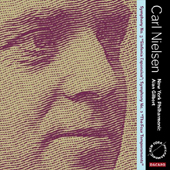

With the structural discipline of Bruckner, the thematic inventiveness of Dvorak, the dark undertones of Rachmaninov, the rugged Nordic character of Sibelius, and a final movement's main theme
reminiscent of British pageantry, the Symphony No. 3, Op. 27, "Sinfonia Espansiva" by Carl Nielsen (1865-1931) stands as one of the most
impressive symphonies of the early part of the 20th century. Written in 1910, at a time when Stravinsky, Mahler, Scriabin and Schoenberg were all forging diverging new paths, Carl Nielsen's music
sounds more like a Nordic extension of Johannes Brahms. Standard, well structured, four-movement sonata form symphonies, but with a sound and character distinctively Danish.
A first movement jam-packed with inventive thematic material, manipulated, developed and transformed in many interesting ways. The material goes through many varied
and fascinating permutations until Nielsen seems to put an abrupt end to the movement as if to say: "Alright, enough fooling around." This leads into a powerfully
evocative slow movement fueled by distant echoes of human voices, searing strings, and desolate winds. Its sustained final chord from the horn section leaves you with
a feeling of blissful calm. And of course, the final movement's main theme, the kind of big tune that sticks in your mind, is what makes this symphony so memorable and
endearing. It's like the main theme of Beethoven's Ninth - simple but magical. For those of you who may remember, it was used, long before Nielsen was widely known, as the musical theme to a television
arts program on Radio-Canada (French CBC) from the 1950s and 60s titled "Les Beaux Dimanches".
Conductor Alan Gilbert leads a stunning rendition aided by full support from all the musicians of the New York Philharmonic who seem to find meaning in each and
every note. Polish and raw energy rolled into one. The 1989 recording by conductor Herbert Blomstedt and the San Francisco Symphony Orchestra (seen here)
as always been considered a popular favorite. Compared to this newcomer, it certainly seems to project more urgency when called for, and the sudden change of tempo
at the very end of the final movement is definitely less jarring in the older recording, but the finer details and orchestral colors that Gilbert pulls out of the New Yorkers
makes the older Decca recording pale in comparison. Commited playing captured in a full-bodied "live" recording in typical Dacapo fashion. The
Symphony No. 2, Op. 16 "The Four Temperaments" which rounds out this disc, enjoys the same dedicated playing and charged interpretation. The
electric energy and rhythmic bounce of its final movement leaps off the page.
Alan Gilbert's contract as music director of the New York Philharmonic has just been extended for another three years. In the plans are recordings of all the symphonies
by Brahms and the remaining four Nielsen symphonies. All well worth anticipating!
Jean-Yves Duperron - October 2012